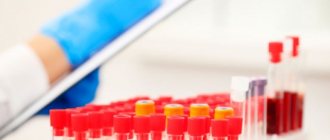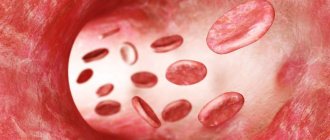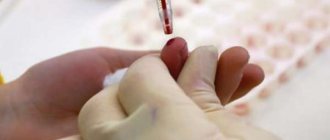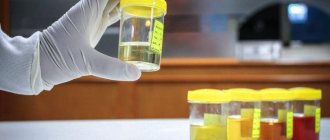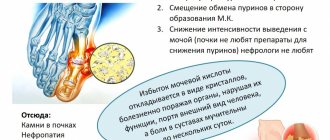Indications for biochemical blood tests
The study is carried out at the first stage of diagnosing any somatic diseases of any profile. It is mandatory to refer a patient for blood biochemistry in case of the following complaints and symptoms:
- Regular disruptions in digestion (nausea, vomiting, heaviness in the abdomen, bloating, flatulence, diarrhea or constipation, heartburn, discomfort in the hypochondrium);
- Sustained pain of any localization (headache, muscle, joint, in the area of internal organs);
- Respiratory disorders (persistent cough, shortness of breath, spasms);
- Signals from the nervous system (tremor of the limbs, chronic fatigue, insomnia, dizziness and fainting);
- Malfunctions of the genitourinary system (changes in the smell and color of urine, changes in the frequency of urination, discomfort during the process);
- Signals from the cardiovascular system (rapid or rare heartbeat, high or low blood pressure);
- Weakness of the immune system, which is expressed in frequent and long-lasting respiratory diseases;
- Pathological changes in the skin and the presence of visible tumors on the body;
- Signs of endocrine disorders (persistent thirst or hunger, sudden changes in weight, constant feeling of heat or cold).
Interpretation of results
Norms vary depending on the gender and age of patients. Significant changes in indicators are observed in many physiological conditions (for example, during pregnancy). Minor deviations may be one of the first signs of various diseases, or may not indicate the presence of pathology. When interpreting the results, the doctor takes into account a large number of factors (history, presence of complaints, etc.). If necessary, additional examination is prescribed.
For adult patients, reference values are 64-83 g/l. In children, the norm is determined in accordance with their age. When assessing results, it is necessary to take into account the patient's level of physical activity. The test is not intended for self-diagnosis. Only a doctor can correctly interpret its results.
How to prepare for donating blood for “biochemistry”?
In order for the results to be as accurate as possible, you must follow the rules for preparing for a blood test for a biochemical study:
- Within two days, switch to a gentle diet - eliminate fatty, sweet, spicy, salty, smoked foods, and also give up alcohol, coffee and strong tea;
- The day before, refrain from any stressful procedures and activities for the body - baths and saunas, contrast showers, heavy physical activity;
- If you are taking medications, discuss with your doctor whether they will affect the test results;
- 6-12 hours before the BAC, you should not eat any food or smoke. You are only allowed to drink plain water.
GENERAL URINE ANALYSIS
It shows the quality of functioning of the excretory system. Before collecting urine, it is necessary to toilet the genitals. An average portion of urine is used for analysis. Urine must be delivered to the laboratory no later than 2 hours after collection.
COLOR
from straw to yellow. The saturation of the yellow color of urine depends on the concentration of substances dissolved in it. The color changes when taking medications (salicylates, etc.) or eating certain foods (beets, blueberries). Turbid urine means the presence of impurities of salts (phosphates, urates, calcium oxalates), bacteria, red blood cells, which may indicate inflammatory kidney diseases.
ACIDITY
urine (RN) depends on the nature of the diet. If you like meat foods, then an acidic urine reaction will be observed during a urine test; if you are a vegetarian or follow a dairy diet, then the urine reaction will be alkaline. With a mixed diet, mainly acidic metabolic products are formed, so it is believed that the urine reaction is normally acidic. An alkaline reaction of urine is characteristic of chronic urinary tract infection, and is also observed with diarrhea and vomiting. The acidity of urine increases in feverish conditions, diabetes mellitus, tuberculosis of the kidneys or bladder, and renal failure.
SPECIFIC GRAVITY
(specific density) characterizes the filtering function of the kidneys and depends on the amount of excreted organic compounds (urea, uric acid, salts), chlorine, sodium, potassium, as well as the amount of urine excreted. Normally, the specific gravity is 1010-1030. Changes in the specific gravity of urine towards a decrease may indicate chronic renal failure. An increase in specific gravity indicates inflammatory kidney diseases (glomerulonephritis), possible diabetes mellitus, large fluid losses or low fluid intake.
PROTEIN
is absent in the urine of a healthy person. Its appearance usually indicates kidney disease, an exacerbation of chronic kidney disease.
GLUCOSE
Normally, it is absent in a general urinalysis.
LEUCOCYTES
Normally they can be present in urine in an amount of 0-5 per field of view. An increase in the number of leukocytes in the urine (leukocyturia, pyuria) in combination with bacteriuria and necessarily in the presence of any symptoms (for example, frequent painful urination, or increased body temperature, or pain in the lumbar region) indicates inflammation of an infectious nature in the kidneys or urinary tract ways.
erythrocytes and bacteria
. Red blood cells can normally be present in urine in an amount of 0-3 per field of view. Bacteria are normally absent in a general urine test. The presence of bacteria is a sign of chronic or acute diseases of the kidneys and urinary tract. A particularly dangerous phenomenon is asymptomatic bacteriuria, that is, the presence of changes in tests in the absence of patient complaints. It is dangerous because it can last as long as desired without appropriate treatment and observation; during pregnancy, inflammatory diseases of the urinary system develop, which has a negative impact on the course of pregnancy and the condition of the fetus.
CYLINDERS
in
a general urinalysis. Cylindruria is a symptom of kidney damage, so it is always accompanied by the presence of protein and renal epithelium in the urine.
Once detected changes in urine are not a diagnosis. To clarify the situation, the doctor will prescribe additional examinations.
Decoding and data of normal indicators
The result of the analysis is a conclusion, which is usually a table about the content of chemicals and biological agents in the blood. The first column indicates the indicator, the second - the identified value, and the third - the normal range. Only a specialist, assessing the indicators, can determine the presence of disturbances in water-salt metabolism, identify inflammatory processes and infections, and also assess the performance status of all the patient’s organs.
As for normal indicators, the data for adults looks like this:
| Analysis | Men | Women |
| Total protein | 64-84 g/l. | 64-84 g/l. |
| Hemoglobin | 130-160 g/l | 120-150 g/l. |
| Haptoglobin | 150-2000 mg/l | 150-2000 mg/l |
| Glucose | 3.30-5.50 mmol/l. | 3.30-5.50 mmol/l. |
| Urea | 2.5-8.3 mmol/l. | 2.5-8.3 mmol/l. |
| Creatinine | 62-115 µmol/l | 53-97 µmol/l. |
| Cholesterol | 3.5-6.5 mmol/l. | 3.5-6.5 mmol/l. |
| Bilirubin | 5-20 µmol/l. | 5-20 µmol/l. |
| AlAT (ALT) | up to 45 units/l. | up to 31 units/l. |
| ASAT (AST) | up to 45 units/l. | up to 31 units/l. |
| Lipase | 0-190 units/l. | 0-190 units/l. |
| Alpha amylase | 28-100 units/l. | 28-100 units/l. |
| Pancreatic amylase | 0-50 units/l. | 0-50 units/l. |
Decoding the main indicators of the LHC
Total protein.
A biochemical blood test determines the total concentration of various proteins, which consist of amino acids. Protein takes an active part in the processes of coagulation, processing and transport of nutrients to organs and tissues.
Hemoglobin.
This specific protein from the red blood cell system is responsible for transporting oxygen in the body
Haptoglobin.
A blood plasma protein that binds hemoglobin and is responsible for preserving iron in the body. Also involved in the control of local inflammatory processes.
Glucose.
An important component responsible for carbohydrate metabolism. Its content in arterial blood is higher than in venous blood.
Urea.
This is the main product of protein breakdown, in which nitrogen unnecessary by the body is removed in the urine.
Creatinine.
This, like urea, is the end product of protein metabolism. The content of creatinine in the blood depends on gender, age, and muscle mass.
Cholesterol
. A component of fat metabolism, which is also involved in the construction of cell membranes and the synthesis of vitamin D and sex hormones. Another name is cholesterol. There are: total cholesterol, low-density lipoprotein (LDL) and high-density lipoprotein (HDL) cholesterol.
Bilirubin
. The breakdown product of hemoglobin, a toxic substance of two types: direct and indirect. They form a “general” one and the norm when deciphering a biochemical blood test is indicated specifically for it.
AlAT (ALT).
Alanine aminotransferase is an enzyme contained in the cells of the liver, kidneys and heart, so its presence in the blood indicates the destruction of the cells of these organs.
AST (AST).
Aspartate aminotransferase is a cellular enzyme that is involved in the metabolism of amino acids and is found in the liver cells of the heart and kidneys.
Lipase.
An enzyme that promotes the breakdown of fats.
Amylase.
It breaks down carbohydrates from food and ensures their digestion. There are alpha-amylase (diastase) and pancreatic amylase.
It is important to remember that only a specialist can evaluate the results of a blood test, decipher a biochemical analysis, make a diagnosis and prescribe treatment!
What deviations in the UAC may mean
For diagnosis, both a current blood test and previous studies are important to track changes. Let's consider what deviations in indicators can mean:
- Red blood cells. Exceeding the value is accompanied by insufficient oxygen supply, dehydration, acquired heart disease, and impaired adrenal function. The level may be lower than normal due to blood loss, iron deficiency anemia, in the second half of pregnancy, and with chronic infectious diseases.
- Leukocytes. Leukocytosis (exceeding the norm) can be caused by physiological characteristics or pathology. In the first case, the causes are: pregnancy, intense physical/psycho-emotional overload, hypothermia/overheating. Inflammatory and oncological diseases, poisoning and allergic reactions are manifested by pathological leukocytosis. With leukemia, bone marrow hypoplasia, liver damage, measles, lymphogranulomatosis, autoimmune diseases, a decrease in leukocytes will be detected.
- Platelets. The amount decreases with leukemia, AIDS, poisoning, bone marrow damage, prolonged therapy with hormones or antibiotics. The indicator goes beyond the normal range with inflammation of the rectal mucosa, osteomyelitis, joint diseases, cancerous lesions, and in the postoperative period.
- Hemoglobin level. Exceeding the norm occurs against the background of an increased platelet count, impaired blood clotting function, after a gastrointestinal disorder, or with an overdose of medications for anemia. Low HGB gives the right to suspect the presence of internal bleeding, kidney dysfunction, malignant neoplasms, and bone marrow damage.
- Erythrocyte indices (MCV, MCH, MCHC). The indicators give an idea of the state of red blood cells and their functionality. MCV is the average volume of one red blood cell; it increases with diseases of the liver and hematopoietic system, lack of folic acid and vitamin B12. Decreased in some types of anemia, hyperthyroidism, hemoglobinopathy. MCH shows the average hemoglobin content in one red blood cell. Analogous to color index. MCHC – average concentration of red blood pigment. The interpretation is carried out taking into account other indices.
- Hematocrit level. Allows you to assess the severity of anemia associated with iron deficiency. Exceeding the norm indicates dehydration, extensive burns, and inflammation of the peritoneum. A low figure gives the right to suspect pathologies of the heart and vascular system, kidney disease, blood disease, extensive blood loss, malaria, and poisoning.
- Reticulocyte count. Exceeding the norm is observed in case of blood loss, poisoning, taking certain medications, during the recovery period after treatment of cancer, diseases of the hematopoietic system, metastases in the bone marrow. A decrease in the number of young red blood cells is caused by: anemia, kidney disease, chronic infections, bone marrow tumors, blood pathologies, myxedema of the thyroid gland, chemotherapy, deficiency of folic acid and vitamin B12.
- ESR. Decreases in heart pathologies, joint diseases, anaphylactic shock. Exceeding the norm is observed during pregnancy, anemia, severe poisoning, exacerbations of chronic diseases, and inflammatory processes in the body.
- Color. Hyperchromia (exceeding the norm) indicates a deficiency of cyanocobalamin, possible polyps in the stomach, various malignant tumors, and a lack of vitamin B9. Hypochromia (decreased color index) indicates anemia or lead poisoning. With normochromia, the doctor looks at the values of other, more informative indicators.
How often should I get tested?
Doctors advise undergoing preventive examinations and general blood and urine tests at least once a year. People with chronic illnesses should get tested twice a year or as directed by their healthcare provider. Tests for HIV and sexually transmitted diseases can be conducted anonymously at least every month. If you have a family history of diabetes, you can take this test once every year or two. In the case of a genetic predisposition to cancer, it is recommended to test for tumor markers every two years.
smear on flora
smear on flora
- microscopy of scrapings from the urethra, the contents of the posterior wall of the vagina and the cervix.
Decoding the smear:
- squamous epithelium
is a layer of cells lining the vagina and cervix. In a normal smear, epithelium should be present. If the smear does not contain epithelium, then the gynecologist has reason to assume a lack of estrogen, an excess of male sex hormones. The absence of squamous epithelium in the smear indicates atrophy of epithelial cells. - leukocytes
- the norm is up to 15 units in the field of view. A small number of leukocytes will be considered normal, since leukocytes perform a protective function and prevent infection from entering the woman’s genitals. Elevated leukocytes in the smear are observed during inflammation of the vagina (colpitis, vaginitis). The more leukocytes in the smear, the more acute the disease. - rods
make up the normal microflora of the vagina. Apart from rods, there should be no other microorganisms in the smear. - small sticks
are most often gardnerella - the causative agents of gardnerellosis or vaginal dysbacteriosis. - “key” cells
(atypical cells) are squamous epithelial cells glued to a small rod. As with Gardnerella, if the smears contain atypical cells, the doctor can diagnose vaginal dysbiosis. - fungus
is a sign of candidiasis (thrush). In latent (asymptomatic) stages of thrush, the fungus in the smear can be detected in the form of spores.
Even if the smear results show the presence of cocci, small rods and “clue” cells indicating bacterial vaginosis, the smear results alone may not be enough to make a diagnosis. It is necessary to conduct an additional examination: bacteriological culture and DNA diagnostics (PCR smear).
BAKPOSEV
The bacteriological method of examining a smear taken from the vagina or urethra is that this material is placed in a special nutrient medium that promotes the proliferation of certain bacteria. Bakposev allows you to differentiate nonspecific bacterial flora, determine the species and quantity of the pathogen. In addition, which is very important for subsequent treatment, bacterial culture makes it possible to determine sensitivity to antibacterial drugs
PCR DIAGNOSTICS
PCR – polymerase chain reaction. The main advantage of the DNA method is that it allows you to determine small quantities of the pathogen, as well as persistent forms of pathogens that are encountered in the treatment of latent and chronic infections. The sensitivity and specificity of the PCR method is high – 95%.
smear for cytology
Cytology smear is a cytological examination of smears taken from the surface of the cervix and from the cervical canal. This test is performed annually on all women over 18 years of age who are sexually active. The procedure is absolutely painless. The examination is not carried out during menstruation and in the presence of an inflammatory process.
Normally, the smear reveals squamous and columnar epithelial cells without any features. The appearance of atypical cells in a smear is a signal of trouble. The cause may be inflammatory processes caused by urogenital infections (mycoplasma, gonococci, trichomonas, chlamydia, etc.), background diseases (erosion, ectopia, leukoplakia, polyps, etc.), as well as precancerous conditions (dysplasia) and malignant degeneration of cells.
Each pathology has its own cytological features, which will be described in the cytogram.
Further examinations depend on the results of cytology: colposcopy (examination of the cervix under magnification using a special device - a colposcope), PCR examination, PAP test, bacteriological examinations (cultures), biopsy followed by histology (taking a piece of tissue from suspicious areas and examination under a microscope).
Why are laboratory tests needed?
Many serious illnesses can occur even in an apparently healthy person. At the same time, at the initial levels of the disease there are practically no symptoms. The blood pressure has increased slightly or the anemia has worsened. Is this a reason to see a doctor and do a bunch of research? Of course yes. If you take general tests periodically and systematically, you can prevent and promptly identify a number of serious diseases and abnormalities. What tests should you take regularly and what can these results tell your doctor about your health? Let's figure it out.
Blood cells, traveling through veins, capillaries and arteries, carry a huge amount of information about the health of the body. Clinical blood and urine tests can tell doctors what state a patient's body is in (including at the cellular and molecular levels). The biochemical composition of the blood always remains unchanged. And every deviation from the norm is a reason to conduct additional examinations of the patient. Therefore, the numbers in the results that are incomprehensible at first glance are an open book for a medical specialist.
The most modern devices and instruments are not capable of providing the information that one drop of blood or urine can provide doctors. With each new result, the overall picture of the health of a particular patient is supplemented, and treatment methods are updated. This helps to avoid many complications and additional diseases.

